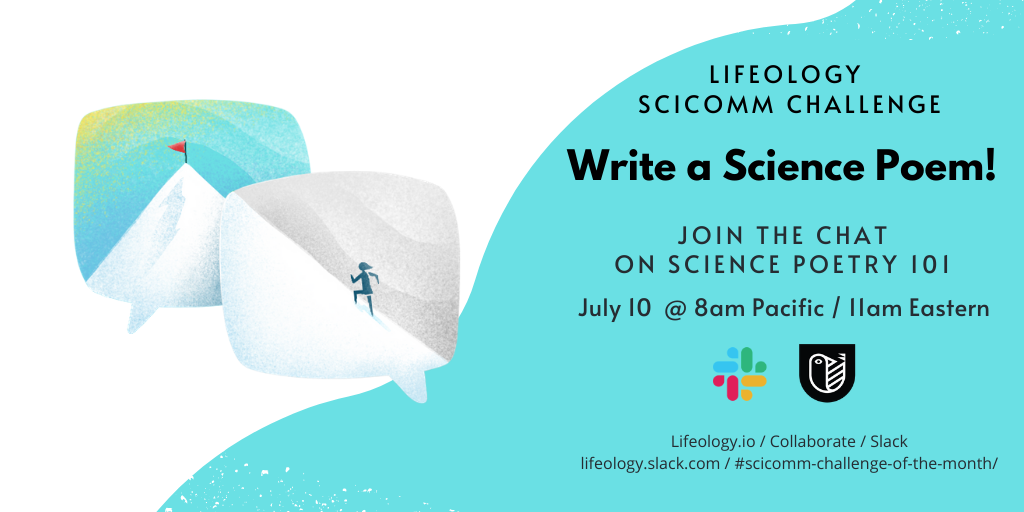
For the month of July, Lifeology is launching our third #SciComm Challenge, a monthly fun challenge that scientists, science writers, artists and anyone else can participate in to improve their science communication skills in a variety of formats!
This month, your challenge is to write a science poem around the theme “Mystery”!
What is a science poem? It is “any verse in which the author has correctly used scientific terminology, concepts, principles or knowledge to provide an analytical view of the world or surrounding universe.” Poetry, like other forms of art, can increase people’s interest and deeper engagement with science. Through poetry, people can process and interpret scientific information in novel ways that better connect that information with their own existing knowledge, values and emotions.
Not only that, but writing science poetry can help make you a better science communicator! My own journey into science writing (Paige speaking) started when I was 12 years old with creative steam of consciousness writing in response to artwork, and free-form poetry writing.
Do you have some tips to help me get started? Here are three tips on writing science poems from science poet Dom Conlon!
- Write as simply as you can.
- Write lots and find the phrases which seem to feel true to you and then develop them into the poem.
- Read everything out loud. It’s easy to let our inner voice take shortcuts. I create images after a long internal dialogue where I’ve chased a rabbit down so many holes that I get lost, but because it’s been my journey, I don’t always acknowledge how lost I am and so emerge somewhere the reader doesn’t recognize. In fact, this metaphor might be one of those places. So I’ll refer you back to item 1) write simply.
Does a poem need to rhyme or have a specific structure? There are many different types of poems! Some have strict structures, such as sonnets, villanelles, haikus, tankas. Others are very open. Free verse is most common of all contemporary poetry – there is no structural form. “It is the culmination of relaxed rules and playful language combinations, allowing for high degree of science-like experimentation. It doesn’t have to rhyme, and any applied rhythm is light, like a flowing thought rather than a Tennyson canter!” says Rachel Rayner.
Read on to learn more about this challenge and to learn more about science poetry from poet Rachel Rayner!
Challenge Details
Write a science poem! Your theme is “mystery“.
Bonus challenge: Ask an artist to “respond” to your poem with an illustration or other piece of artwork! Submit their artwork with their permission along with your poem (make sure to attribute them). Format: 1:1 or any other format that would fit on an A4 sheet of paper, 1ooo x 1000 pixel minimum.
Submit your poem to Lifeology@lifeomic.com and include “Poem for Lifeology SciComm Challenge” in the headline!
Your poem should include no more than 50 lines of text, in any format, and should include a bolded title. Submit your poem as a pdf if you’d like to ensure any special formatting you create.
In your e-mail submission, include a short explainer of what this poems means to you personally and what motivated you to write it. (Although your the poem should be able to stand on its own, without this explainer.)
Our favorite entry at the end of the month will be rewarded with a complementary “response” illustration, a paid opportunity for a science artist!

Want to learn more about science poetry before you write your own science poem? Join the Lifeology team and science poets including Rachel Rayner on Friday, July 10 and 8 am Pacific / 11 am Eastern for a Q&A and live chat on science poetry writing!
Join the chat in the #scicomm-challenge-of-the-month channel within the Lifeology Slack Workspace. Join the Slack workspace here and then navigate to the chat channel here. Submit your questions for our experts ahead of time – e-mail Lifeology@lifeomic.com.

A science or nature photograph can be great inspiration for a poem. A poem might help us dive into the details but also step back to understand science in a larger, human, emotional context. Photo by Olivier Mesnage on Unsplash.
About Science Poetry
by Rachel Rayner, a science poetry writer and researcher
Poetry can be deeply personal: scribbling away, late at night, never to be seen. It is a way to flood the page with expression, bring it to order with a stanza, and create a completely subjective beauty. Sharing a poem can be quite the brave act, but your poetry should be shared. Science poetry, especially.
Science poems are no different to other poetry. There are many common elements: rhythm, the occasional rhyme, illusive meanings, dramatic imagery and metaphors that unveil new visions of mundane things, and an unravelling of language that explores how we communicate. Science poetry has the added dimension of expressing scientific ideas, theories and frameworks, or utilizing an enormous vocabulary (corolla for petals, electromagnetic radiation for light), and it brings these things to a new audience in a potentially captivating way.
“Creative expression of scientific observations and principles through poetry and other media can enrich medical and science education. This debunks the expectation that science and poetry, for example, are mutually exclusive.” – Sherry-Ann Brown
I have always enjoyed reading and writing poetry, but I hadn’t heard of science poetry until I attended the Quantum Words festival (hosted by WritingNSW). One of the guest poets there, Carol Jenkins, is hugely influential to me. I love that she gently uses mathematical equations in her poetry, such as in ‘Cloud Me’. (A reading of this work, and many others — keep an ear out for my favourite, ‘Pollen’ — are in this Australian radio interview). Using my scientific background for inspiration and content became a natural part of my writing. For example, all the components of the Standard Model rhyme! What a useful trait for a limerick:
The leptons leapt over the bosons,
And the gluons held on to the hadrons.
When they all hit lead,
It was the muon who said,
“I wish I had the power of the photons!”
Photons are illuminating my current work. A new poem of mine, ‘Photonics’, has been published amongst some incredible poems in a brand new journal, Consilience, made just for science poetry.
I have also conducted research into science poetry in collaboration with fellow science poet Dr Michael Leach. In this research, we aimed to do a few things: figure out who was writing science poetry (mostly women), how they were writing science poetry (mostly free verse), and what was the poetry about (mostly biology, and an exploration of what it means to be human). As a necessity, we had to define a science poem and we came, ultimately, to this:
“A science poem is any verse in which the author has correctly used scientific terminology, concepts, principles or knowledge to provide an analytical view of the world or surrounding universe. The poem could be related/responding to stimuli or reflecting the scientific method in some way. Importantly, the poem need not be about science. Instead, it may use science to further the expression of the writer.” – Leach, M., Rayner, R., “The Demographics and Characteristics of Contemporary Australian Science Poetry”
Defining this was very difficult for me (which you can read more about here). Really, poetry is about taking something that is deeply interesting to you and writing about it in a new and striking way.
Poetry is about exploring language – go experiment!
Fun Quiz:
The equation, ((12 + 144 + 20) + (3 × √4)) ÷ 7 + 5 × 11 = 9² + 0, can be communicated in a limerick form! Can you work out what it might be? (If you get stuck, scroll all the way down to the bottom of this blog post to find the answer!) This is most commonly attributed to Leigh Mercer, a British mathematician and wordplay expert.
More Reading
Journals, collections and poetry projects
- Rabbit, a journal on non-fiction poetry (the next edition will be purely science poetry) http://rabbitpoetry.com/
- FIVE:2:ONE, a journal for experimental literature, including “cross-genre scientists” http://five2onemagazine.com/. My limerick above was turned into a concrete poem by my co-author and published in this journal.
- Graviton wants to “observe & examine the phenomenons of the world & exhibit what pulls, pushes, exerts us to create”.
- Antarctic Poetry, an annual competition to write, and photograph your poem, which is then exhibited in Antarctica.
- The Sciku Project, where science papers are summarized into a haiku (thus, a Sciku).
- The Math Haiku Project, a collection of maths-related haiku emphasizing pieces “intended to help teachers and students teach and understand mathematical concepts.”
- Cordite Poetry Review Issue 83: Mathematics
- Pangyrus, an online journal that publishes poetry and has a focus on science, particularly “topics based around science in today’s political climate and women in science & engineering (WISE).”
- Pulse—Voices from the Heart of Medicine, an online publisher of personal stories of illness and healing, including poetry and haiku.
- The Science Made Marvellous series that was published in Australia for National Science Week 2010: Earthly Matters: Biology and Geology Poems; Holding Patterns: Physics and Engineering Poems; Law and Impulse: Chemistry and Mathematics Poems.
Research
- “Are scientific abstracts written in poetic verse an effective representation of the underlying research?”
- Carbera, M. (2008). The poetry of science: Effects of using poetry in a middle school ELD science classroom. Electronic Journal of Literacy through Science, 7, 1-42
- Collett, T. J., & McLachlan, J. C. (2006). Evaluating a poetry workshop in medical education. Medical Humanities, 32, 59-64
- Feasey, R. (2006). Using stories and poems in science. Primary Science Review, 92, 8-10.
- Furlan, P. Y. Kitson, H., & Andes, C. Chemistry, poetry, and artistic illustration: An interdisciplinary approach to teaching and promoting chemistry. Journal of Chemical Education, 84, 1625-1630.
- Henriksen, D. (2014). Full STEAM ahead. Creativity in excellent STEM teaching practices. The STEAM Journal, 1.
- Schuster, S. E. (1994). Haiku poetry and student nurses: an expression of feelings and perceptions. Journal of Nursing Education, 33, 95-96.
- Walders, D. (2000). Poetry and science education. ERIC Digest.
Other
Poetry on the Move is an annual poetry festival held in Australia’s capital, Canberra, every year with leading international poets. Listen to the panel on science poetry here.
Check out this interactive periodic table that brings up a haiku on each element, by Mary Soon Lee.
Dr Sam Illingworth is a leading science communicator, particularly focussed on science poetry. He has plenty of books, articles, resources and a great podcast to help you on your science poetry journey (I realize that we differ somewhat in our purpose of science poetry, he recommends not using scientific ‘jargon’ whereas I love the use of beautiful, potentially complex words – poetry is all about language, after all!)
Quiz Limerick
A dozen, a gross, and a score
Plus three times the square root of four
Divided by seven
Plus five times eleven
Is nine squared and not a bit more.





